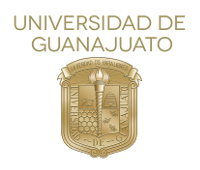Please use this identifier to cite or link to this item:
http://repositorio.ugto.mx/handle/20.500.12059/5102Full metadata record
| DC Field | Value | Language |
|---|---|---|
| dc.rights.license | http://creativecommons.org/licenses/by-nc-nd/4.0 | es_MX |
| dc.creator | Luis Gerardo Moreno Ciénega | - |
| dc.date.accessioned | 2021-06-02T18:07:04Z | - |
| dc.date.available | 2021-06-02T18:07:04Z | - |
| dc.date.issued | 2018-11-26 | - |
| dc.identifier.uri | http://repositorio.ugto.mx/handle/20.500.12059/5102 | - |
| dc.description.abstract | Los organismos se encuentran en constante exposición a factores intra- y extracelulares potencialmente capaces de modificar la estructura del ADN provocando mutaciones y/o muerte celular. Para contrarrestar los efectos adversos del estrés oxidativo, el cuál impacta el ADN generando la base analoga 8-OxoG, Bacillus subtilis cuenta con el sistema de reparación de la Guanina oxidada (GO) constituido por MutY (YfhQ), MutM y MutTA (YtkD). Las frecuencias de mutación espontanea debidas a la interrupción individual y colectiva de los tres genes que codifican a este sistema han sido previamente descritas en nuestro laboratorio. A la fecha se desconoce la contribución en pares de dichos genes; para abordar este punto, en el presente estudio se construyó una colección de cepas de B. subtilis con los siguientes genotipos: ΔmutY-ytkD, ΔmutM-ytkD, y ΔmutM-mutY. Para caracterizar las mutantes dobles se realizaron ensayos de mutación espontánea de resistencia a rifampicina (Rif); los resultados obtenidos se contrastaron con respecto a la cepa parental silvestre (WT) | es_MX |
| dc.language.iso | spa | es_MX |
| dc.publisher | Universidad de Guanajuato | es_MX |
| dc.relation | http://www.jovenesenlaciencia.ugto.mx/index.php/jovenesenlaciencia/article/view/2618 | - |
| dc.rights | info:eu-repo/semantics/openAccess | es_MX |
| dc.source | Jóvenes en la Ciencia: Verano de la Investigación Científica. Vol. 4, Num 1 (2018) | es_MX |
| dc.title | Generación y caracterización fisiológica de cepas de Bacillus subtilis con genotipo mutTA/mutM, mutY/mutM y mutTA/mutY | es_MX |
| dc.type | info:eu-repo/semantics/article | es_MX |
| dc.subject.cti | info:eu-repo/classification/cti/6 | es_MX |
| dc.subject.keywords | B. subtilis | es_MX |
| dc.subject.keywords | Sistema GO | es_MX |
| dc.subject.keywords | Mutagénesis | es_MX |
| dc.type.version | info:eu-repo/semantics/publishedVersion | es_MX |
| dc.creator.two | NORMA RAMIREZ RAMIREZ | - |
| dc.creator.three | MARIO PEDRAZA REYES | - |
| dc.creator.idtwo | info:eu-repo/dai/mx/cvu/36247 | es_MX |
| dc.creator.idthree | info:eu-repo/dai/mx/cvu/13835 | es_MX |
| dc.description.abstractEnglish | All organisms are constantly exposed to intra- and extracellular factors that can potentially modify the structure of the nucleic acids promoting mutagenesis and/or cell death. To counteract the adverse effects of oxidative stress, which after attack of DNA generates the base analog 8-OxoG, B. subtilis relies on the GO system composed by MutY (YfhQ), MutM and MutTA (YtkD). The spontaneous mutation frequencies of strains carrying single or triple disruptions on the genes encoding the GO system have previously been reported. However, the contribution of double disruptions in these genes is currently unknown; to address this aspect, in the present study a collection of null mutants with the following genotypes were constructed: ΔmutY-ytkD, ΔmutM-ytkD, y ΔmutM-mutY. The spontaneous mutation frequencies to rifampcin resistance were determined for the strains obtained and contrasted with those obtained for the wild type parental strain. | - |
| Appears in Collections: | Revista Jóvenes en la Ciencia | |
Files in This Item:
| File | Description | Size | Format | |
|---|---|---|---|---|
| Generación y caracterización fisiológica de cepas de Bacillus subtilis con genotipo mutTAmutM, mutYmutM y mutTAmutY.pdf | 386.03 kB | Adobe PDF | View/Open |
Items in DSpace are protected by copyright, with all rights reserved, unless otherwise indicated.

